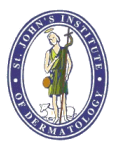The term ‘Phototherapist’ used below is defined as any Health Professional who directly delivers Phototherapy to patients.
SE England Phototherapy Network standards v12
Each unit has an up to date list of individuals who play a role in phototherapy.
All phototherapists are involved in some form of clinical governance activity at least twice per year in a governance meeting which covers the topics of : Clinical Incidents, health and safety, Audit, Guidelines, reveiw of the Unit’s results from the South-East England Phototherapy Network Audit.
A) Staff Education and Training
A phototherapist must be a Physiotherapist registered with the HcPC or a registered nurse. All phototherpy staff must undertake a period of supervised practise with a qualified phototherapist and be signed off as ‘competent’. During this period, clinical notes of patients treated by the trainee should be countersigned by a ‘competent’ phototherapist.
It is recognized that, prior to the introduction of these standards some Phototherapists working long term do not possess this level of nursing or physiotherapy qualification. For this group the following applies: if a phototherapist is not a Chartered Physiotherapist or a Registered Nurse, they must demonstrate that
1) they have been working as a physiotherapist in the UK in a recognized phototherapy unit for a minimum of 5 years prior to 1st January 2015
2) they can show they have been signed off by a recognized Physiotherapist* in all relevant competencies (*a chartered Physiotherapist or a Registered nurse who has undertaken a period of supervised practice with a qualified physiotherapist and been signed off as ‘competent’.)
All phototherapists to have attended at least one phototherapy course in the past
All members need to have completed a period of supervised practice for up to 3 months full time or extended proportionately if part time, supervised by a fully trained phototherapist.
All phototherapists must have passed their formal Clinical Competencies in all relevant Clinical Skills following the period of supervised practised.
All phototherapists should attend at least one phototherapy update/ educational session per year, as provided by this Network or elsewhere.
B) Calibration and Maintenance of Equipment: “All phototherapy equipment must be regularly inspected and maintained so as to provide safe and effective treatment.”
Regular, at least annual, mechanical and electrical safety inspection of equipment must be carried out by a suitably qualified person, typically a medical physicist or company engineer.
Annual formal calibration of the equipment must be carried out by either a medical physicist or company engineer, or a properly trained member of staff with that person providing irradiance figures to the phototherapist, using a meter calibrated to traceable national standard eg UKAS
Annual inspections of each piece of eqipment should include a risk assessment or a review of any existing risk assessment. Risk assessments should include consideration of occupational ultraviolet exposure to staff.
Irradiance measurements on phototherapy equipment must be made and recorded regularly using a handheld UV meter, by the phototherapist team. The measurement interval must be adequate to ensure changes in irradiance of more than 20% do not go unmonitored. This interval will be quarterly for all equipment.
Handheld meters used for UV irradiance measurements in the unit should be calibrated annually.
C) Patient Pathway
All referrals for phototherapy must be from a Consultant Dermatologist or other clinician under the direct supervision in that clinic of a Consultant Dermatologist.
The Dermatologist must include the following in the patient referral to Phototherapy: Details about absence or presence of any contraindications or risk factors to Phototherapy; details of which type of Phototherapy is being requested and which disease is being treated and details of previous phototharapy.
There must be a record of informed patient consent when the Dermatologist has seen the patient, either formal written consent or a record of the process in the patient’s notes that the patient has verbally given informed consent.
Every patient to be given a patient information leaflet with regard to the treatment they are receiving.
A patient information leaflet available for every phototherapy treatment provided in the Unit.
A formal nursing assessment pre-phototherapy must be recorded in the nursing or medical notes which should include the following information: – cumulative doses of phototherapy, blood results, allergies and current medication.
90% of patients to start treatment within 6 weeks of referral to phototherapy. 90% of patients referred urgently to phototherapy to be treated within 3 weeks.
All clinical details of every appointment and every course of treatment to be recorded in a standardized agreed manner in a patient record which is easily accessible.
All departments to use written evidence-based treatment guideliness for all forms of phototherapy that are given by the Unit, including discharge protocols.
Every unit to have a named Phototherapy Lead Consultant.
All patients with a cumulative total of 200 whole body PUVA or 300 whole body UVB treatments should have annual dermatological review to assess for signs of actinic damage and actinic damage related lesions. NB – These are not lifetime limits, but checkpoints for practitioners to be aware of. Treatments beyond these ‘checkpoint’ doses is then the clinical decision of the Consultant Dermatologist, based on individual patient risk factors and disease severity and alternative treatment options.
Timetabling of Phototherapy appointments to allow sufficient time in appointments for the delivery of safe and effective treatment: minimum 20 minutes for first appointment and minimum 15 minutes for all subsequent appointments.
D) Minimum Phototoxic Dose
Do MPDs or PUVA test dose for PUVA. MPDs will be compulsory, when an MPD tester becomes available.
Do MEDs for UVB phototherapy or show evidence of working towards doing MEDs.
Bob Sarkany
John Ferguson
Trish Garibaldinos
Nichola Mair
SE England Phototherapy Standards version 12 February 2019

